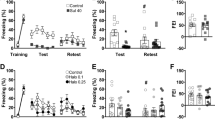Summary
Two experiments, designed to determine the effects of anticholinergics on fear-conditioning, are reported. The results indicate that scopolamine and atropine were not effective in reducing the conditioning of fear. These experiments indicate that previous findings suggestive of attenuated habituation with the antichiolnergics, cannot reasonable be accounted for in terms of a general memory deficit. Other data pertinent to this finding are discussed.
Similar content being viewed by others
References
Burešová, O., J. Bureš, Z. Bohdanecký, and T. Weiss: Effect of atropine on learning, extinction, retention and retrieval in rats. Psychopharmacologia (Berl.) 5, 255–263 (1964).
Carlton, P. L.: Some effects of scopolamine, atropine, and amphetamine in three behavioral situations. Pharmacologist 3, 60 (1961).
—: Some behavioral effects of atropine and methyl atropine. Psychol. Rep. 10, 579–589 (1962).
—: Cholinergic mechanisms in the control of behavior by the brain. Psychol. Rev. 70, 19–39 (1963).
—: Brain-acetylcholine and stimulus selection. Brain Chem. Behavior Res. Project Newsletter 9, 2 (1964).
- The hippocampus, brain-acetylcholine and habituation. Paper presented at symposium on brain, biochemistry and behavior, AAAS meetings, Berkeley, 1965.
—: Scopolamine, amphetamine and light-reinforced responding. Psychon. Sci. 5, 347–348 (1966).
—, and J. R. Vogel: Studies of the amnesic properties of scopolamine. Psychon. Sci. 3, 261–262 (1965).
Estes, W. K., and B. F. Skinner: Some quantitative properties of anxiety. J. exp. Psychol. 29, 390–400 (1941).
Goodman, L. S., and A. Gilman: The pharmacological basis of therapeutics. New York: Macmillan 1965.
Hearst, E.: Effect of scopolamine on discriminated responding in the rat. J. Pharmacol. exp. Ther. 126, 349–368 (1959).
Leaf, R. C., and S. A. Muller: Simple method for CER conditioning and measurement. Psychol. Rep. 17, 211–215 (1965).
Meyers, B.: Some effects of scopolamine on a passive avoidance response in rats. Psychopharmacologia (Berl.) 8, 111–119 (1965).
—, and E. F. Domino: The effect of cholinergic blocking drugs on spontaneous alternation in rats. Arch. int. Pharmacodyn. 150, 525–529 (1964).
Vogel, J. R.: Brain-Acetylcholine and habituation. Unpublished Masters thesis, Rutgers University 1965.
Whitehouse, J. M.: Effects of atropine on discrimination learning in the rat. J. comp. physiol. Psychol. 57, 13–15 (1964).
Author information
Authors and Affiliations
Additional information
Research supported by Public Health Service grant MH-08585.
Rights and permissions
About this article
Cite this article
Vogel, J.R., Hughes, R.A. & Carlton, P.L. Scopolamine, atropine and conditioned fear. Psychopharmacologia 10, 409–416 (1967). https://doi.org/10.1007/BF00403981
Received:
Issue Date:
DOI: https://doi.org/10.1007/BF00403981



